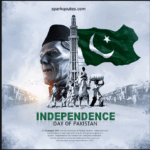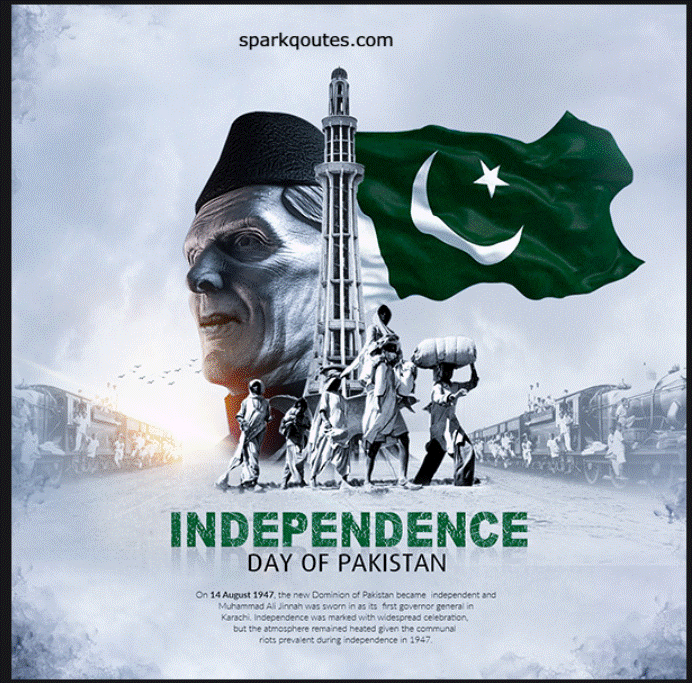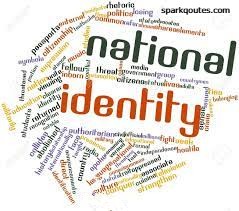Introduction: A Nation’s First Breath
On 14 August 1947, at the stroke of midnight, a new flag unfurled over the lands of South Asia. From the tragedy of Partition to the pride of nationhood, Pakistan began its journey—driven by vision, shaped by sacrifice, and defined by resilience.

Chapter 1: The Road to Division 🎢
A Changing Political Landscape
By the early 20th century, British India’s struggle for independence was dominated by the Indian National Congress. Yet, many Muslims felt their identity and political influence were being overshadowed—a concern that led to the founding of the All‑India Muslim League in 1906.
A Vision for a Separate Homeland
In 1930, philosopher-politician Sir Muhammad Iqbal notably expressed the idea of a separate Muslim homeland. The idea gained broader political legitimacy when the League passed the Lahore Resolution in 1940, asserting that Muslim-majority regions deserved full autonomy.
Intensifying Tensions and Hope
World War II weakened British authority and intensified calls for self-rule. The Quit India Movement of 1942 was launched by Congress, while the Muslim League strengthened its campaign for a separate nation. By the mid‑1940s, political pressure, communal unrest, and British readiness to leave India all converged toward the inevitability of Partition.
Chapter 2: Epochal Decisions in 1947 🏛️
The Mountbatten Plan
In June 1947, Lord Mountbatten proposed a plan for Partition. A few weeks later, the British Parliament passed the Indian Independence Act, setting 15 August 1947 as the date of liberation. Pakistan chose to mark its independence on 14 August, which coincided with the holy month of Ramadan and allowed for smoother administrative divisions.
A Midnight Proclamation
As fields lay quiet and lamps dimmed, Muhammad Ali Jinnah—Pakistan’s future founder—prepared a speech. At midnight on 14 August, he addressed the jubilant crowd:
“At this solemn moment, I affectionately felicitate the people of Pakistan… and I am confident that you will meet your responsibility well.”
Just hours later, the first national flag began to flutter in Karachi, symbolizing a new country’s sovereignty.
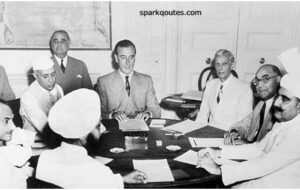
Chapter 3: Partition’s Pain and Rising Hope 💔🌅
Mass Exodus and Communal Riots
Partition’s birth was marred by intense suffering. An unprecedented population exchange occurred: over 10 million people were displaced; estimates of casualties range from 200,000 to 2 million. Punjab and Bengal saw the worst of it—neighbor killing neighbor, community against community.
Rebuilding Amid Rubble
Amid the chaos, Pakistan had to establish government institutions from scratch—no unified civil service, no shared banking systems, and no clear military command. It was a race against time to create functional ministries, courts, and infrastructure.
Welcoming the Refugees
The newborn nation witnessed rivers of humanity crossing its borders—Hindu and Sikh evacuees out, Muslim migrants in. Housing camps in Lahore, Karachi, and Peshawar sprang up overnight. Millions were wounded, stateless, and often penniless. Volunteers and officials worked day and night to alleviate suffering.
Chapter 4: Architecting a Nation 🏛️
Leaders Who Shaped the State
Muhammad Ali Jinnah, hailed as Quaid‑e‑Azam (“Great Leader”), became the country’s first Governor-General. His responsibilities were immense: uniting leaders, stabilizing the system, and guiding refugees.
Liaquat Ali Khan assumed the role of Pakistan’s first Prime Minister. His emphasis was on creating economic policies, drafting a constitution, and forging foreign alliances.
Laying the Ideological Framework
In 1949, the government adopted the Objectives Resolution, asserting that sovereignty belongs to Allah, to be exercised through democratic institutions. This statement laid the foundation for Pakistan’s constitutional identity.
The Kashmir Conflict
Almost immediately, Pakistan faced a crisis over Kashmir. The Maharaja’s indecision led to tribal incursions and military confrontation. In 1947–48, Pakistan and India fought their first war, ending in a UN-negotiated ceasefire—but without resolving the underlying dispute.
Chapter 5: Building National Identity 🌿
Symbols of Pride
Flag: A white crescent and star on a green field, representing progress and unity.
Anthem: “Qaumi Tarana,” adopted in 1954, offered spiritual resonance and patriotic zeal.
Slogans: Chanting “Pakistan Zindabad!” (“Long Live Pakistan!”) became commonplace at public events, fostering unity across diverse provinces.
Celebrating the First Anniversary
On 14 August 1948, the nation observed its first Independence Day with parades, speeches, and flag hoisting. It was a bittersweet celebration—honoring freedom even as pains from Partition lingered.
Chapter 6: Early Triumphs and Trials
Jinnah’s Death and a Leadership Vacuum
In September 1948, Jinnah passed away after just 13 months of leadership. His death left a profound void in Pakistan’s politics and identity—that sense of charismatic unity would prove difficult to replicate.
Constitutional Challenges
Pakistan struggled to craft a cohesive constitution. The debate between a secular parliamentary framework and an Islamic legal system raged on. This conflict would echo through future regimes and military interventions.
Economic and Social Hurdles
Agriculture was the backbone of early Pakistan. However, rural unrest, illiteracy, and poverty begged urgent attention. With limited resources and divergent regional needs, balancing development proved a tough task.
Chapter 7: A Legacy in the Making 🌱
Vision for a New Nation
Pakistan’s founding generation—visionaries like Jinnah, Liaquat, and Iqbal—articulated a nation rooted in Muslim identity yet committed to democratic pluralism. Their words still echo through courts, textbooks, and political discourse.
Lessons from the Past
Partition demonstrated that political boundaries can be drawn—but hearts and histories remain entwined. Pakistan’s early history teaches that national pride often arises from coping with adversity; a lesson seen in every landmark from refugee rehabilitation to constitutions.
The Symbol of Independence Day
Today, 14 August is celebrated with military flyovers, flag-raising ceremonies, school plays, and heartfelt speeches. It’s a reminder of origins amid upheaval, yet also a celebration of sovereignty and development.
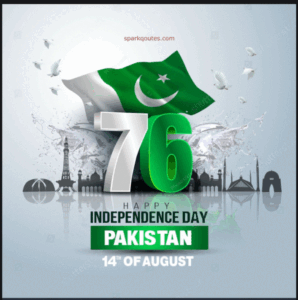
Conclusion: From Pain to Purpose
“From Partition to Pride” is more than a passage—it’s a national epic. Pakistan’s journey began in darkness and bloodshed; yet, from the broken promises of 1947 emerged institutions, identity, and hope. By asserting its flag over a new nation, Pakistan declared its stature on the world stage—an enduring testament that from division, a resilient pride can grow.


